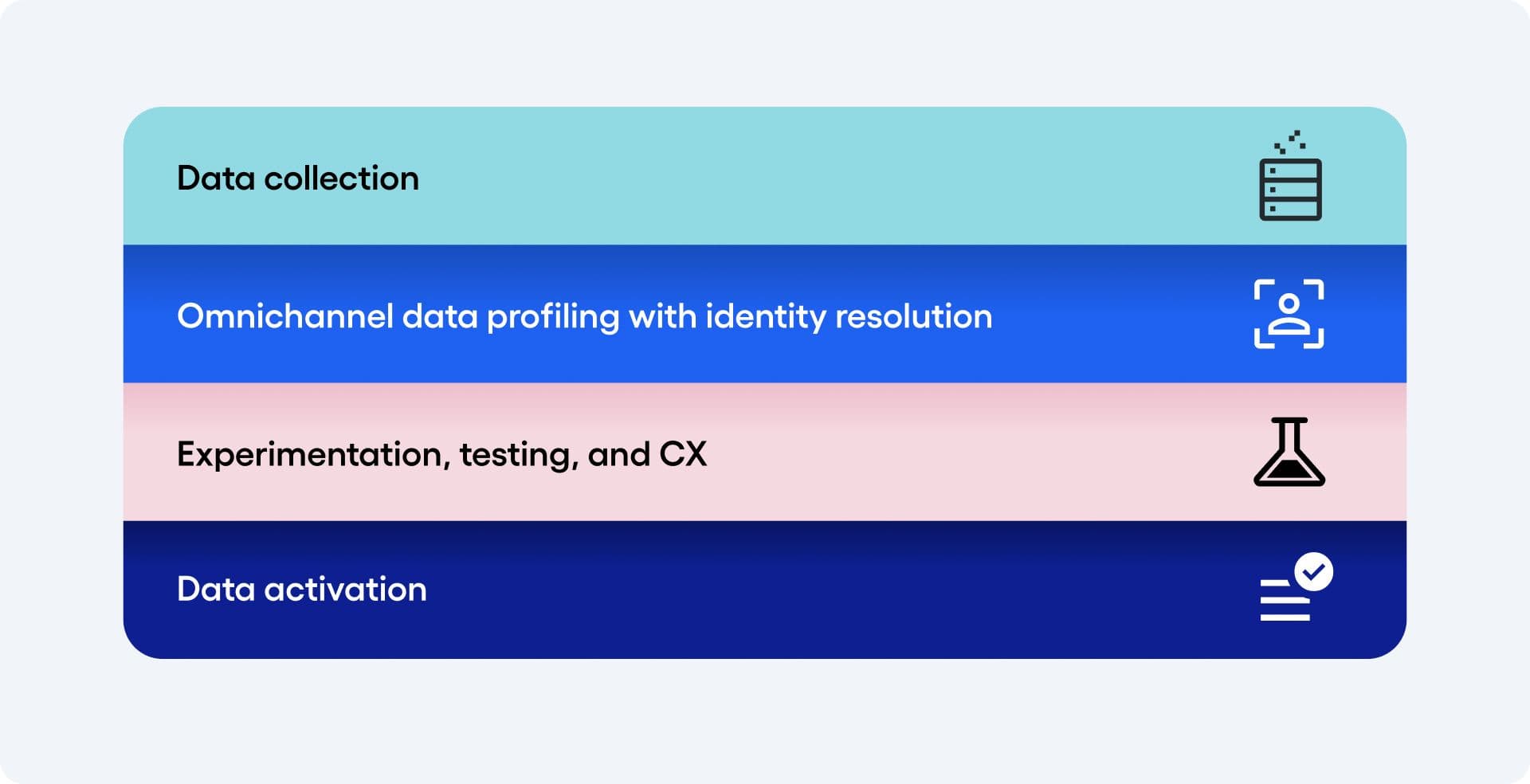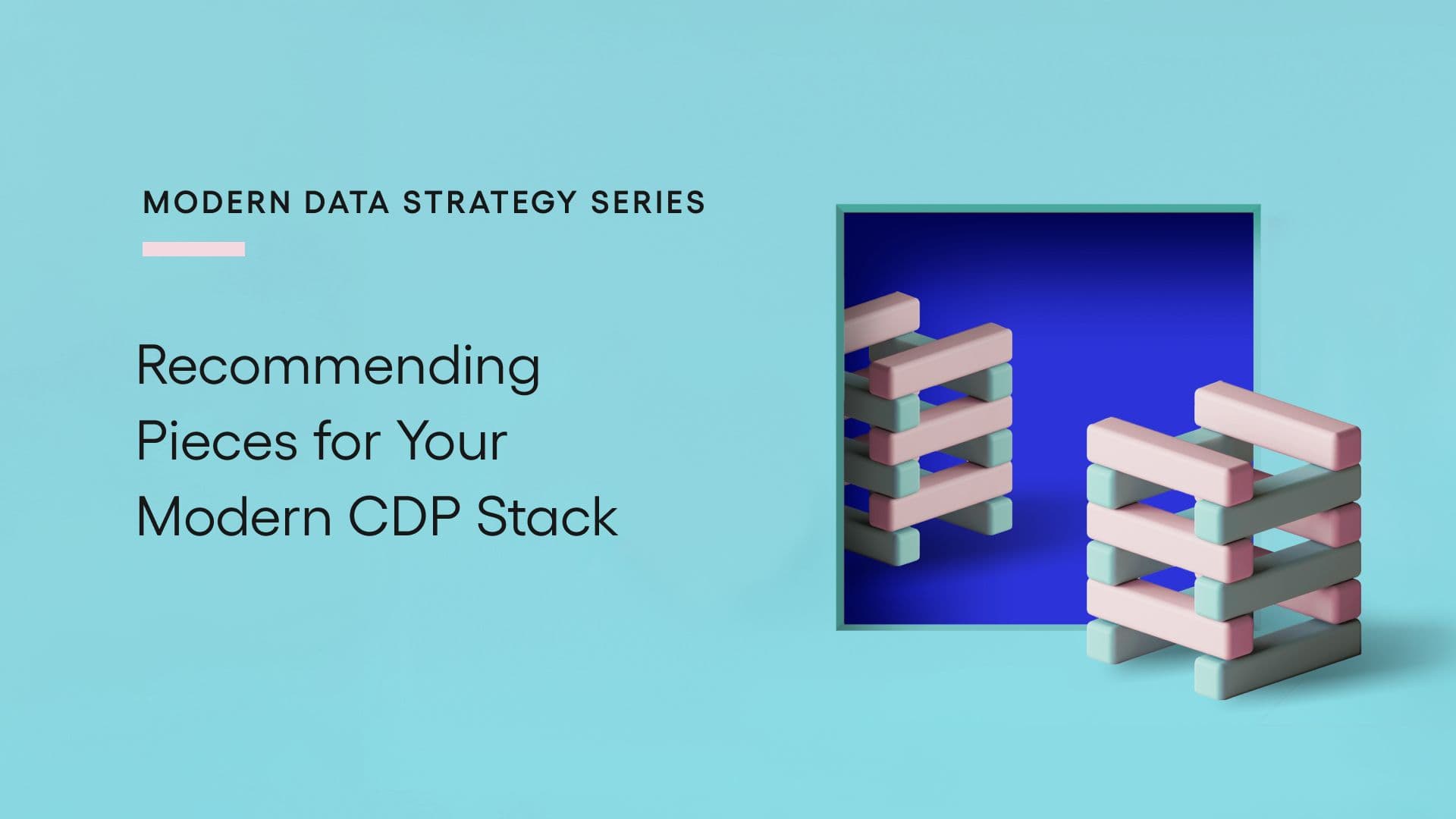Recommending Pieces for Your Modern CDP Stack
Embrace composable architecture with these technologies
Customer data technologies are far more efficiently managed as an agile system. That’s why the composable approach makes sense for a team looking to use technology to create advantages in the ever-changing modern data landscape.
Composable tools let you mix and match technologies to meet the needs of your specific team without falling behind on current trends in marketing, advertising, privacy, and customer data.
Benefits of a composable customer data stack
The goal of this strategy is to give your team more control over the way you operate and scale. It also offers cultural changes that empower different users to focus on meeting specific needs. Since the CDP is a core piece of the composable architecture, we’ve already explored the evolution of the modern CDP in other blog posts. Here are a few outcomes we see from well-implemented composable CDPs:
- Self-service: It’s no longer necessary to endure a six-week training plan for every single tool that your team purchases. With the advent of AI and the acceptance of community-driven knowledge, organizations are adopting technologies that accelerate past the traditional means of onboarding. The composable CDP gives teams an opportunity to select tools that are meant to be self-service.
- Scaled pricing models: Modern CDP vendors have adopted a pricing model similar to that of compute and storage. It usually looks like event-driven pricing that organizations can scale as needed. As long as usage is aligned with a tight data definition, teams can pretty easily avoid paying for unnecessary data or features.
- Agility: The SaaS space is competitive. Every vendor knows that if their technology fails to prove its value, it will be quickly replaced. Amplitude understands this model and so does every vendor in a composable system. Constant validation and innovation is a part of the process for every piece of your composable CDP, your vendors will always be striving to continue winning your business
- Future proof: Most vendors today understand that integrations into Martech and Adtech stack are basic needs for any team. Some organizations (especially startups) don’t have the resources to maintain all these necessary data integrations on their own and they rely on their vendors for the data connections. With most vendors providing integration capabilities and owning the maintenance, companies that use composable CDPs can focus on their own roadmap rather than servicing their stack.
The technologies we recommend
There are many different variations of customer data systems when composable principles are followed. Within this best-of-breed strategy, one size does not fit all. Every department within the organization will have their own preferences for technologies to capture, analyze, and activate data. However, the commonalities that each variation share involve the automation of data collection as it surfaces on devices and systems, and the subsequent data flows to the rest of the composable stack for enrichment and activation.
These commonalities are the basis for the MACH Alliance. The MACH Alliance is a nonprofit advocacy and certification body, founded in June 2020, that champions a modern, composable approach to enterprise technology. Their mission is to “future-proof businesses by empowering them to embrace MACH principles—creating connected, interoperable ecosystems through open and composable architectures.”
Organizations deciding on technologies for a composable customer data system can measure the worthiness of candidacy by observing the strengths each vendor presents on four core design principles:
- Microservices-based
- API-first
- Cloud-native SaaS
- Headless architecture
Amplitude is a member of the MACH Alliance, and we adhere to these design principles within our product suite. Our Analytics, Experimentation, Guides and Surveys, Session Replay, and Voice of Customer tools can be licensed and scaled to meet a digital marketing team’s needs for insights-to-action.
With Amplitude providing capabilities to automate the collection and activation of customer data, organizations have a variety of complementary technology vendors that they can snap on to their composable architecture.
Here’s a look at our preferred technology, split up into phases:

Data collection phase: No surprise here. We recommend Amplitude to govern data collection for the web and app, for the purpose of efficiently providing the insights that marketers need to understand the customer journey on these devices. However, customer data surfaces in many other systems besides consumer devices. Going beyond the web and the app, customer data can surface within Data Warehouses, CRMs, MDMs, and the like. It is important for both data compliance and marketing efficiency that any selected data collection tool be connected to the central hub.
Amplitude provides integration APIs to route its collected data as described, but also can exchange data with other technologies prior to doing so. For example, a data collection pipeline can be configured to have Amplitude expand its data collection automation to also receive propensity scores from an external data warehouse that is calculating them. Organizations may also choose to split data collection responsibilities to a number of different vendors, and use the same data pipeline configuration to centralize them to a central hub after their work is done. There are several vendors in the MACH membership roster that complement Amplitude’s automation here, allowing an organization to choose between a combination of device-based data collection (using SDKs) and modern cloud-based data collection (using APIs) to achieve their data collection goals.
Omnichannel data profiling with identity resolution: While Amplitude will profile and form cohorts of web and app users, data clouds are the ideal platform for unifying the data arriving from the aforementioned pipelines. This omnichannel of systems (e.g., CRM, MDM, Warehouses) will result in different views of the same person, and require profile processing to unify the fragments.
The two most critical functions in the composable data flow at this point are data profiling and identity resolution. Whereas Amplitude may contribute web and app identity, other systems may contribute additional identity tokens that round out the complete customer dataset. As customer data arrives from each source into the data cloud hub, additional identity management functions seek to find common identity values among the fragments. Once a common identity value exists between two data sets, the identity management software conducts identity resolution and unifies the fragments to a single customer view. Because one fragment may have different attributes than another, the unified profile gains additional fidelity and becomes more valuable to marketers. This mitigates risk, since it adheres to the principles of data minimization. It also improves the strength of the organization’s competitive advantage, because a unified customer profile is far more likely to drive future revenue and customer satisfaction than a fragmented assembly that may be outdated or incomplete. Underpinning the profiling and identity resolution is the capability of “no-copy” data viewing and transmission. It mitigates risk and decreases storage costs for composable platform components to view data from the central data cloud without having to make a copy of it. In the cases that require copying data (e.g. when a guide/survey needs data on the client side in real time, or when a personalization tool needs to embed certain profile attributes in its delivery to the browser), the chosen technology must be able to toggle that aspect on and off.
Amplitude delivers this toggled approach with many of its charts and graphs where feasible, and many other vendors in the MACH Alliance share this important feature.
Experimentation, testing, and CX: Amplitude is the leading vendor for product analytics, experimentation, and guides & surveys (which are a form of “zero party data”). Since Amplitude integrates these additional capabilities on top of analytics data layer customers are already using, they can be certain they’re getting a seamless, synced stack.
Amplitude’s quantitative and qualitative capabilities give teams powerful tools to analyze how cohorts of users behave. Those insights can easily be turned into behavior-based personalizations that drive more impactful promotions and improved retention. Giving Amplitude this responsibility has direct ROI into the effort because:
- Designing and deploying experiments requires an event-based data layer in the web and the app. Amplitude is already operating a data layer for its analytics, so there’s no extra effort to create experiments.
- Qualitative analysis is the key to understanding where to engage users with surveys, personalized content, and helpful guides within the customer journey. Amplitude offers this qualitative data with Session Replay. You can also design guides and surveys to take advantage of qualitative insights with a seamless configuration in our unified interface.
- Product teams need feature flagging to run product-led growth tactics, making Amplitude’s existing data layer a valuable part of web and app campaigns.
Data activation: Data activation is a term used to encompass the complete process of collecting relevant customer data, processing it for use as profiles/audiences, and transmitting it to one or more destinations. During collection, Amplitude will form audiences using preconfigured criteria that map to marketing, product, and IT use cases. These data sets will then sync to the data cloud for omnichannel unification using advanced identity resolution that can connect them directly to any platform. The audiences populate in real time and are designed for direct transmission for any number of use cases.
In the early design of the composable CDP, the data cloud and Amplitude can manage the initial use cases for activation. As the system matures and optimizes labor processes, it is commonplace to encounter advanced use cases that require alternative identity tokens, automated journey orchestration, and sophisticated tasks such as preparing customer data for a data clean room exchange with other brands. To manage these additional tactics, several MACH Alliance vendor members can build new layers of sophistication upon the original activation process. These vendors are known for their ability to activate using Reverse ETL, a method that doesn’t require the activated data to be copied and re-stored.
The final step in this composable flow is delivery of the activated data to one or more systems of engagement. The leading marketing teams will orchestrate activation across channels to provide a connected experience. The market provides dozens of quality vendors that can conduct automated multichannel marketing, using every channel. Many of these Digital Marketing technologies work directly with Amplitude in addition to the larger composable CDP, giving organizations a variety of choices to draw up these pipelines. So long as the central data cloud is consistently storing the unified profile, teams can choose to send data to these Digital Marketing destinations via Amplitude, the composable CDP, or both.
Modernize your marketing stack
In the current generation of marketing technology, this composable approach should give your team all the power and flexibility you need to understand your audience better and efficiently engage with them. Better yet, composability gives you the flexibility to adapt as the landscape (and your team) changes. In a composable strategy, agility in vendor selection is the key to success. Amplitude’s partner ecosystem provides the means for a comprehensive and integrated suite of technologies that will fit your business.
If your team wants to learn more about setting up a composable marketing architecture for your data, the Amplitude team can help. Just fill out a contact form and one of our experts will set up some time to talk you through any questions you have.

Ted Sfikas
Field Chief Technology Officer, Amplitude
Ted Sfikas is Amplitude’s Field CTO for the Go To Market team, delivering Digital Strategy, Martech, and Customer Data expertise to clients worldwide.
More from TedRecommended Reading

AskNicely Cuts Analysis Time by 75% with Amplitude AI
Jan 6, 2026
8 min read

The Product Benchmarks Every Travel and Hospitality Company Should Know
Jan 5, 2026
5 min read

The Product Benchmarks Every Healthcare Company Should Know
Dec 29, 2025
5 min read

The Product Benchmarks Every Media and Entertainment Company Should Know
Dec 23, 2025
5 min read

